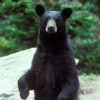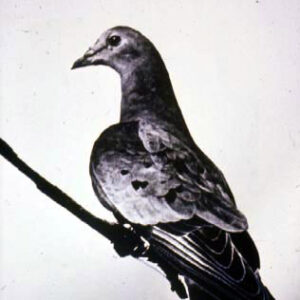calsfoundation@cals.org
Passenger Pigeons
aka: Ectopistes migratorius
The passenger pigeon (Ectopistes migratorius) was a North American bird species in the order Columbiformes (pigeons and doves) that became extinct in the early twentieth century. The fate of the passenger pigeon serves as a graphic lesson in the misuse of natural resources, as the species went from an almost indescribable abundance to extinction in only a few decades. The decline came primarily as a result of relentless persecution of its breeding colonies by market hunters, largely for meat, with no (or ineffectual) regulation that might have maintained a stable population.
The passenger pigeon had the same general body shape as the common and familiar mourning dove (Zenaida macroura) but was larger and somewhat more colorful, with areas of slate-blue and pinkish coloration. Like the mourning dove, the species was a fast flier, traveling at around sixty miles per hour.
Passenger pigeons nested in eastern North America generally north of a line from Kansas to Virginia. Their wintering range extended south to the Gulf Coast. The species lived in immense flocks year-round, roaming nomadically to areas with abundant food resources—primarily acorns, beech nuts, and chestnuts. Passenger pigeons were described as existing “in such prodigious numbers, as almost to surpass belief” by bird artist Alexander Wilson in 1812. Wilson observed a single flock of passenger pigeons that he estimated to comprise 2.3 billion individuals. In Canada in 1866, another flock was estimated at 3.7 billion. Though it is impossible to know the total population, estimates range to as high as 5 billion; the figure may have been much higher. (By contrast, current population estimates for the mourning dove, one of the most abundant land birds in North America, range from 350 to 475 million.)
Because passenger pigeons nested in tightly packed colonies, it was easy for hunters to find them and kill huge numbers in a short time. With the advance of railroads across the eastern United States, it became practical to ship large quantities of pigeons to markets in urban areas. For a period of many years, such persecution caused adult birds to abandon virtually all their colonies, leading to a complete failure to produce new generations of fledglings. The result was a rapid and devastating collapse of the entire population. Still abundant in the 1870s, the passenger pigeon was rare by the 1890s. The last individual died in the Cincinnati Zoo in 1914.
Although the passenger pigeon was reported to have nested in Oklahoma, Kansas, Missouri, and Mississippi, there are no records of breeding in Arkansas. The species was abundant in the state in winter, however, arriving in October and departing on its northward migration in March or April. Ornithologists believe that passenger pigeons preferred swampy habitat in winter. Before human-induced habitat changes, much of eastern Arkansas was a vast contiguous area of seasonally flooded bottomland hardwood forest where acorns would have been plentiful.
The French explorer Jean Bernard Bossu described “whole clouds” of passenger pigeons in northeastern Arkansas in 1751, and surveyor George William Featherstonhaugh observed “incredible quantities” of the birds in the same region in the 1830s. Historical accounts describe instances of mass slaughter of passenger pigeon flocks in the Grand Prairie area of eastern Arkansas in the late nineteenth century.
The map of eastern North America has scores, if not hundreds, of place names including the word “pigeon,” legacies of summer breeding colonies and winter roost sites. In Arkansas, there are sites named Pigeon Roost Mountain in Conway and Pulaski counties; Pigeon Roost Creek in Columbia, Johnson, and Lonoke counties; and Pigeon Hills in Bradley County, among other “pigeon” places.
The last reported passenger pigeon in Arkansas is said to have appeared at a Little Rock (Pulaski County) market in 1899, having been killed near Cabot (Lonoke County).
For additional information:
Baerg, W. J. Birds of Arkansas. Fayetteville: Agricultural Experiment Station, University of Arkansas College of Agriculture, 1951.
James, Douglas A., and Joseph C. Neal. Arkansas Birds, Their Distribution and Abundance. Fayetteville: University of Arkansas Press, 1986.
Mel White
Little Rock, Arkansas
 Environment
Environment Extinct Animals [Historic Period]
Extinct Animals [Historic Period] Last Passenger Pigeon
Last Passenger Pigeon 




Comments
No comments on this entry yet.